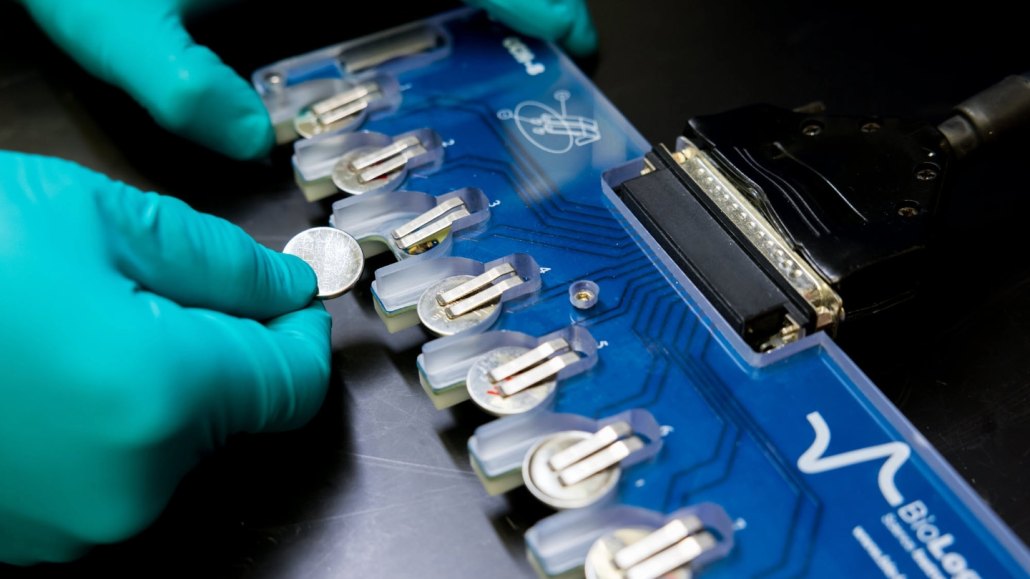Artificial intelligence helped design a new type of battery
The process narrowed 32 million candidate materials to a few dozen in just 80 hours

A new type of battery is based on a material discovered with the help of artificial intelligence.
Dan DeLong/Microsoft
Share this:
- Share via email (Opens in new window) Email
- Click to share on Facebook (Opens in new window) Facebook
- Click to share on X (Opens in new window) X
- Click to share on Pinterest (Opens in new window) Pinterest
- Click to share on Reddit (Opens in new window) Reddit
- Share to Google Classroom (Opens in new window) Google Classroom
- Click to print (Opens in new window) Print
This is another in a year-long series of stories identifying how the burgeoning use of artificial intelligence is impacting our lives — and ways we can work to make those impacts as beneficial as possible.
With more and more devices being powered by batteries, there’s a hunt to find new, safer and cheaper materials to use in those batteries. Doing that has traditionally involved tinkering in the lab — with lots of trial-and-error. But artificial intelligence (AI) could speed up that process, new research shows. And it hints that computers might help identify new materials for batteries to meet specific needs.
A team of 11 researchers in Washington started with a huge pool of potential materials for a new battery. Some of the researchers worked for Microsoft in Redmond. Others worked at the Energy Department’s Pacific Northwest National Laboratory (PNNL) in Richland. In all, the team came up with more than 32 million candidate materials. The group then used AI to help narrow that list down to just 23 promising options. From there, they picked one — and built a working battery.
It’s not the first time scientists have used AI to predict how materials might behave. But past work typically hasn’t led to making a new material.
“The nice thing about this paper is that it goes all the way from start to finish,” says Shyue Ping Ong. He is a materials scientist who did not take part in the new research. He works at the University of California, San Diego.
They focused on the electrolyte
Batteries work by converting chemical energy to electrical energy. (That’s true for AA batteries and for the lithium-ion (Li-ion) batteries in your phone and laptop.) Batteries do this with the help of something called an electrolyte. Atoms that have an electric charge — ions — can flow through that electrolyte.
Electrolytes can be liquid or solid. Standard Li-ion batteries use a liquid type. But those liquids can pose risks, such as leaks or fires. So scientists have looked to design solid electrolytes. The Washington team hoped to make such an electrolyte for batteries.
To create their initial set of possible candidates, they looked at the structures of materials in known electrolytes. Then they asked a computer to swap different elements into those electrolyte recipes. It was like a game of chemical mix-and-match. That’s how the researchers came up with those 32 million candidate electrolyte recipes.
Sorting through this giant list with traditional methods would have taken decades, says Nathan Baker. He’s a chemist at Microsoft who led the new research. But with AI, the researchers were able to pare down the list in just 80 hours. They used a type of AI called machine learning. It can make quick predictions based on patterns learned from known materials.
Solid results
The Washington team then used AI to drop from the list any potential ingredient too unstable to exist in the real world. That brought the list down to fewer than 600,000 candidates. Next, AI selected ones likely to have traits that would be good for batteries.
From there, the researchers used methods that are more accurate than AI. They applied tried-and-tested, physics-based methods. These complex calculations required a powerful supercomputer. It helped model what features the materials might have as an electrolyte. The team also weeded out what would be rare, toxic or expensive ingredients.
Now, only 23 candidates were left. Five were already known. The research team picked a new material that seemed promising. It was stable and conducted electricity well. And it was related to materials the researchers already knew how to make.
Back in the lab, they produced this novel electrolyte. Then they used it to make a prototype battery — which worked.
“That’s when we got very excited,” says Vijay Murugesan. He’s a materials scientist on the team at PNNL. From when they started trying to make the material to when they had a working battery took only about six months. “That is superfast,” he says.
The team shared its findings in a paper published January 8 on arXiv.org. (Studies on this site have not yet been vetted by other experts.)
Do you have a science question? We can help!
Submit your question here, and we might answer it an upcoming issue of Science News Explores
An unexpected matchup
The new electrolyte is similar to a known one. It contains lithium, yttrium and chlorine. But the new one swaps in sodium for some lithium. That’s an advantage, as lithium is costly and in high demand.
Mixing lithium and sodium is uncommon in electrolytes. Usually, “we would not mix these two,” says Yan Zeng. She works at Florida State University in Tallahassee. A materials scientist, she did not work on the new project. It’s more common to use either lithium or sodium ions, not both.
The two types of ions both conduct electricity. So they might be expected to compete with one another, lowering an electrolyte’s overall performance. But the new material highlights one of AI’s benefits, Zeng notes. It “can sort of step out of the box” to try things human minds might not.







